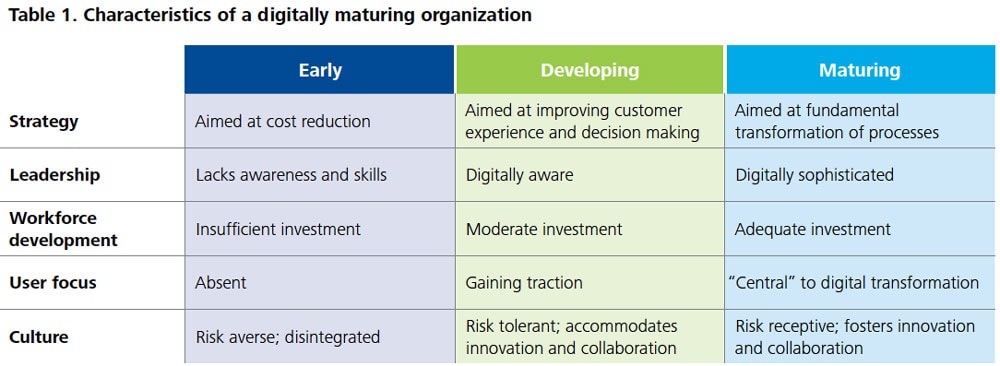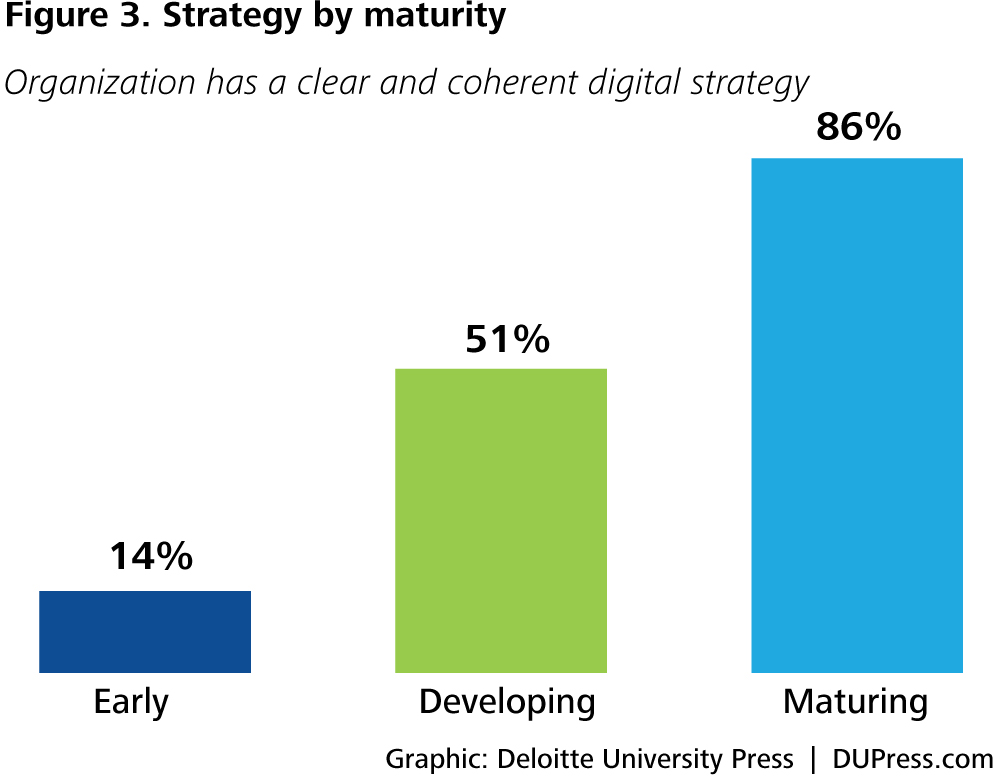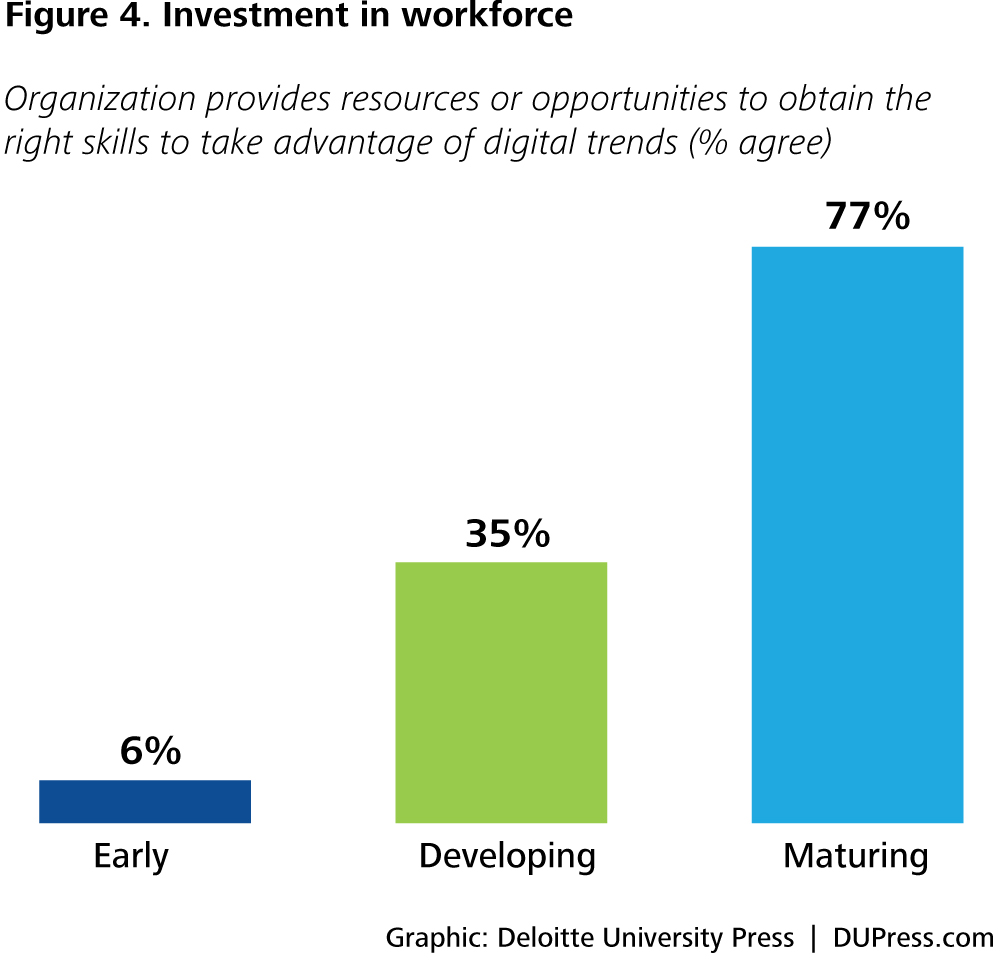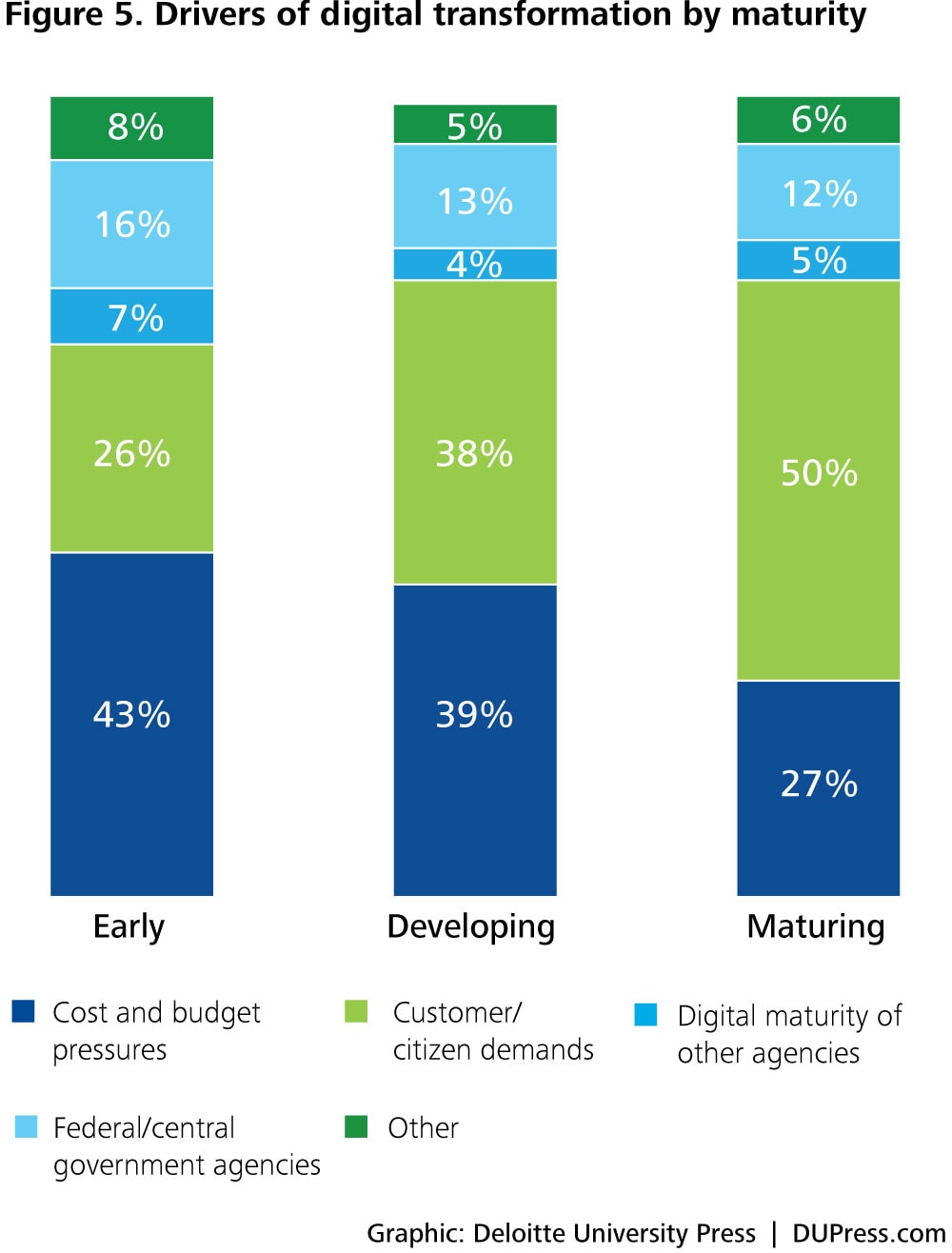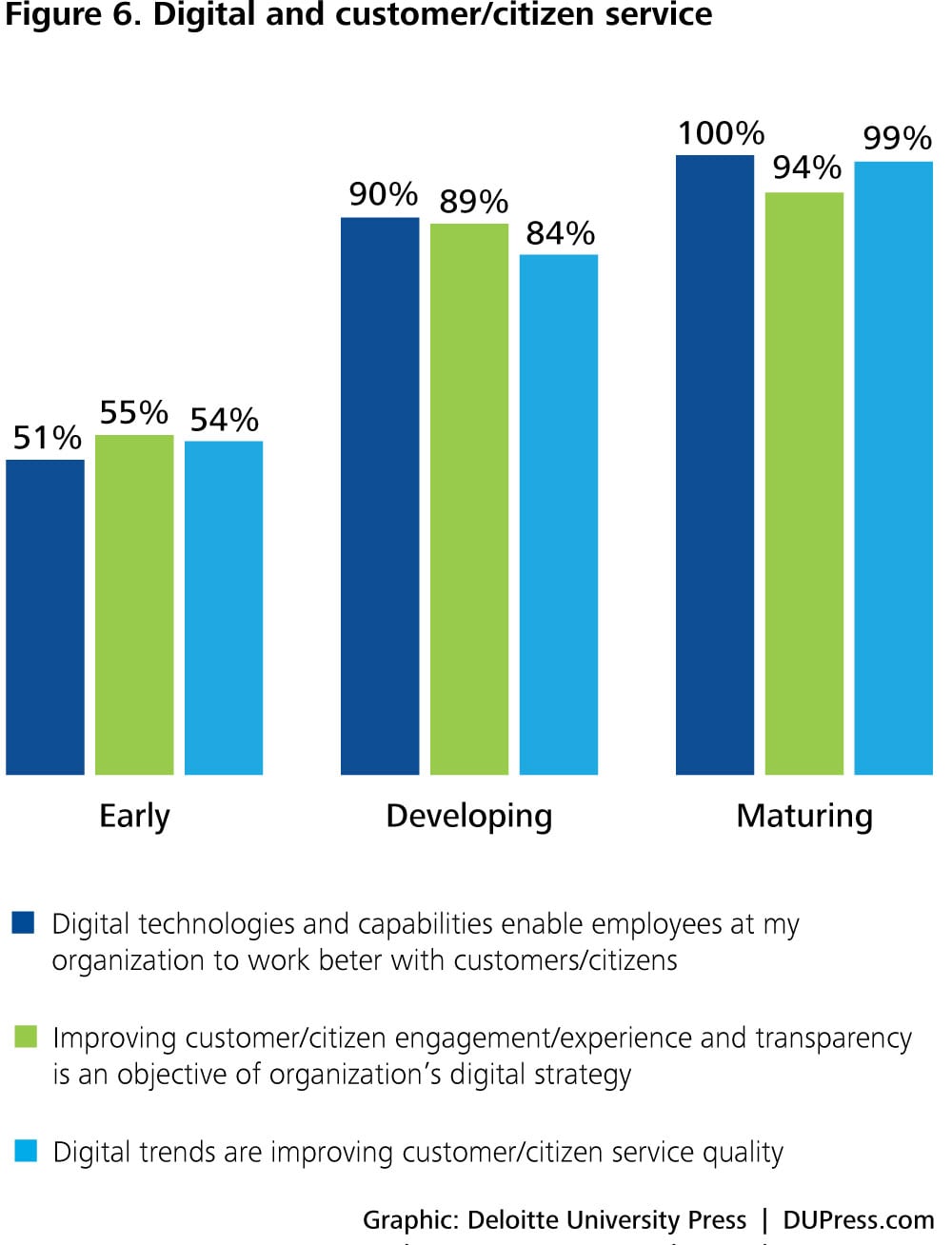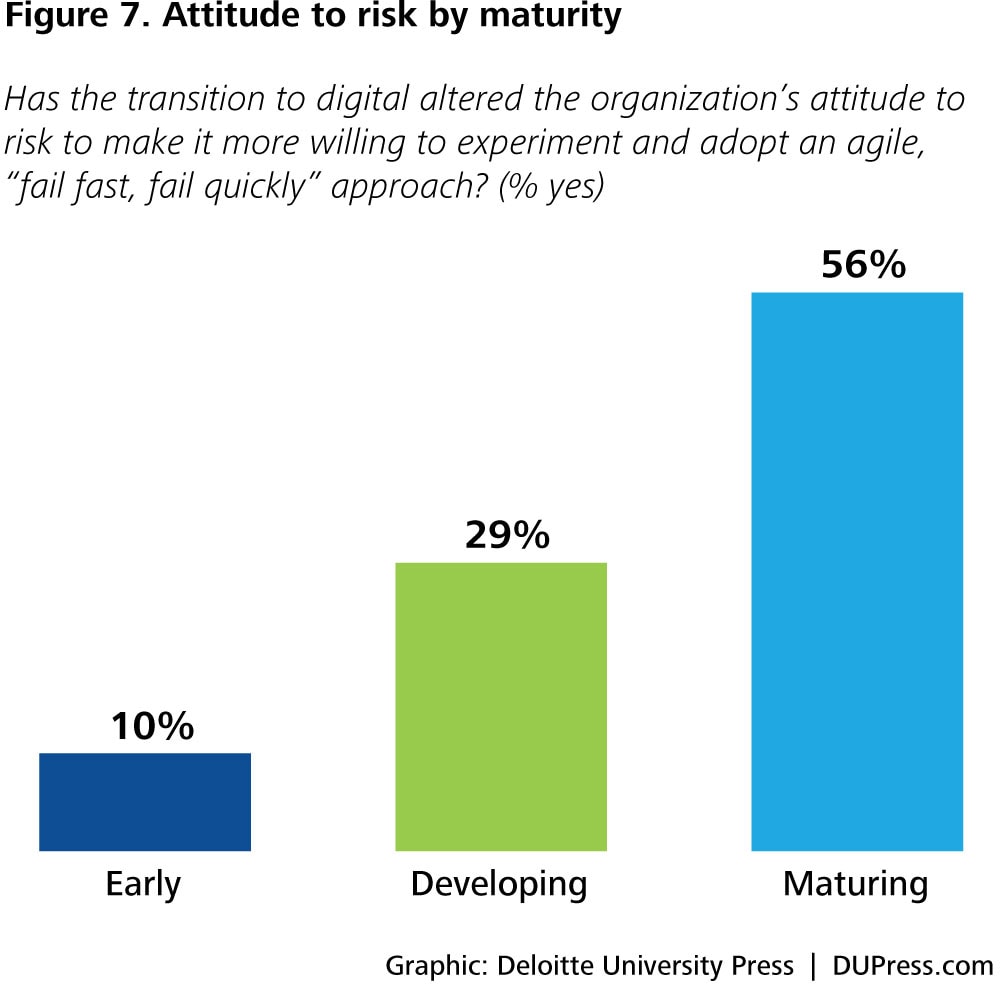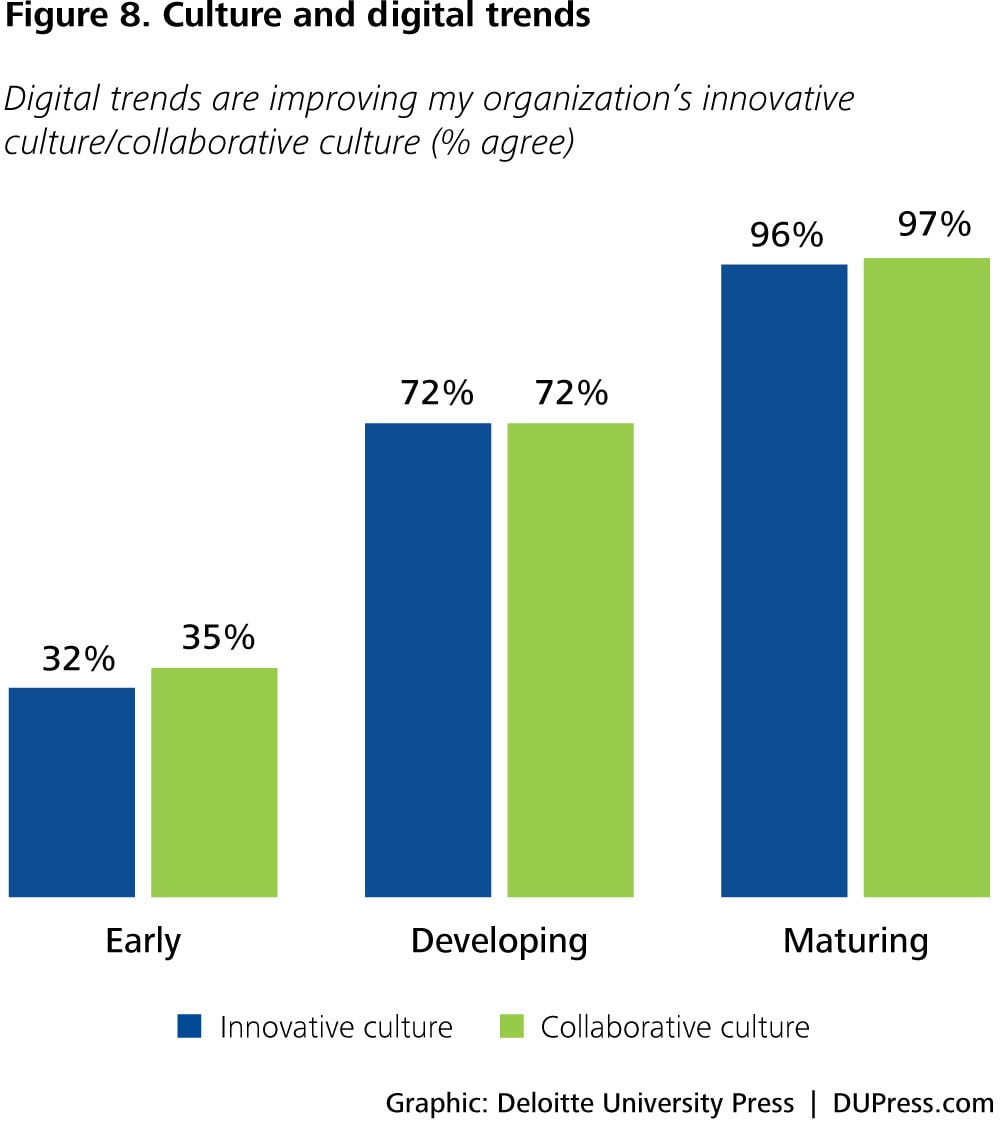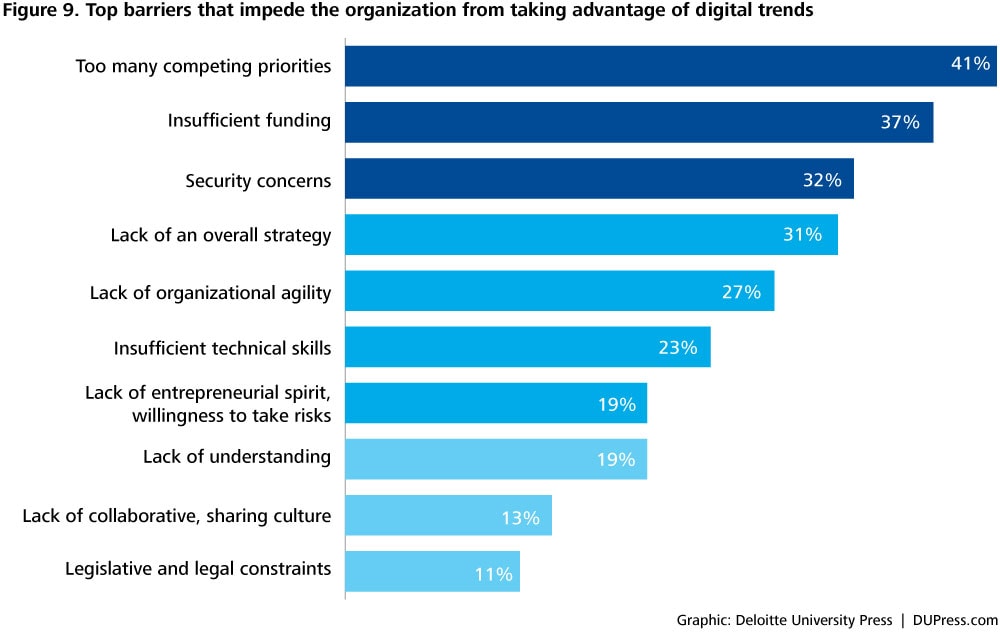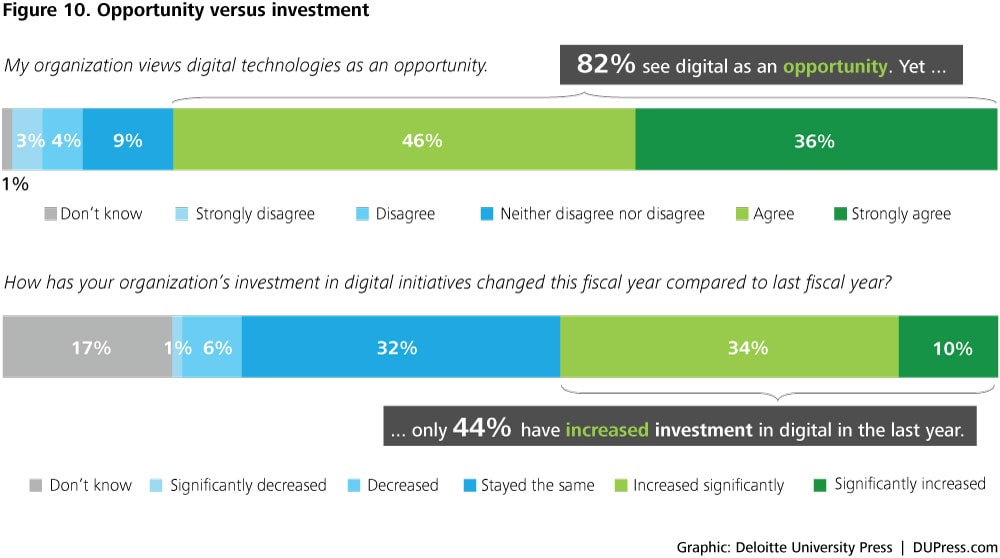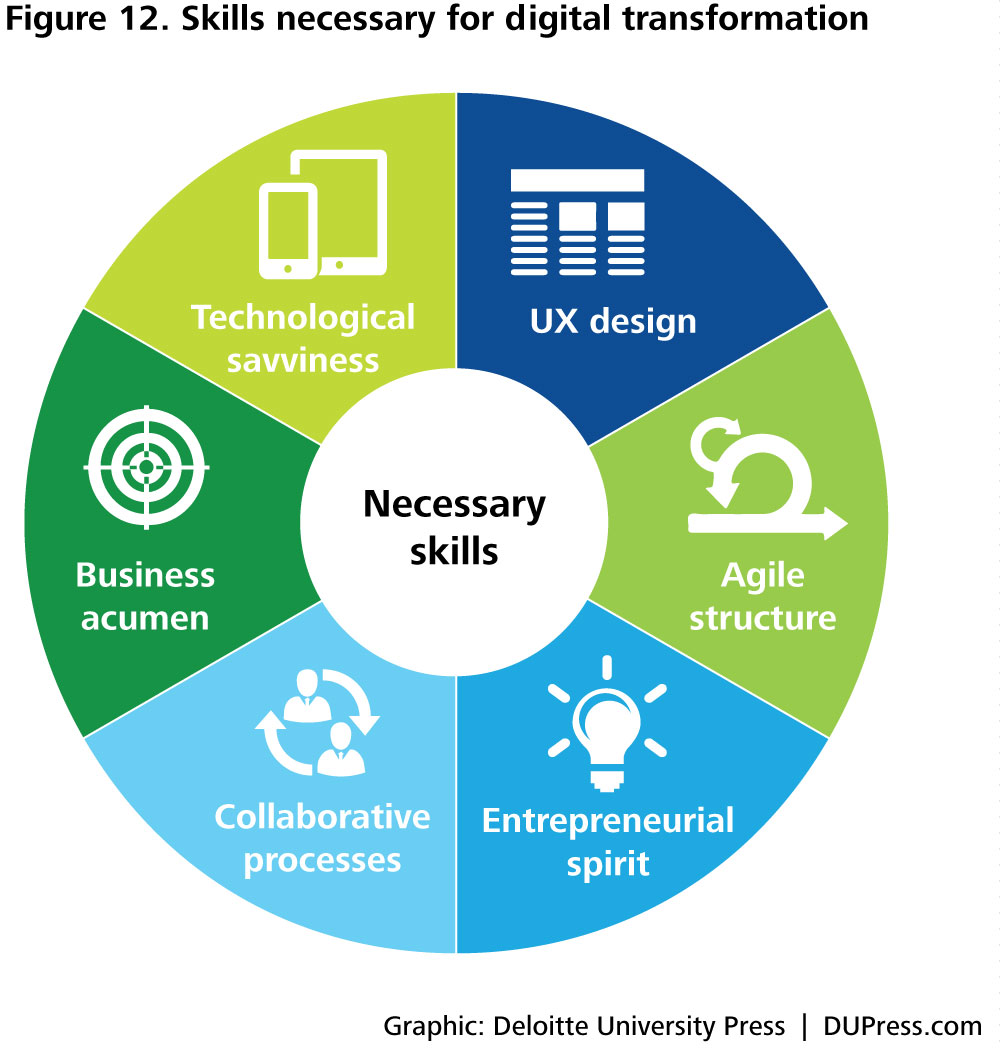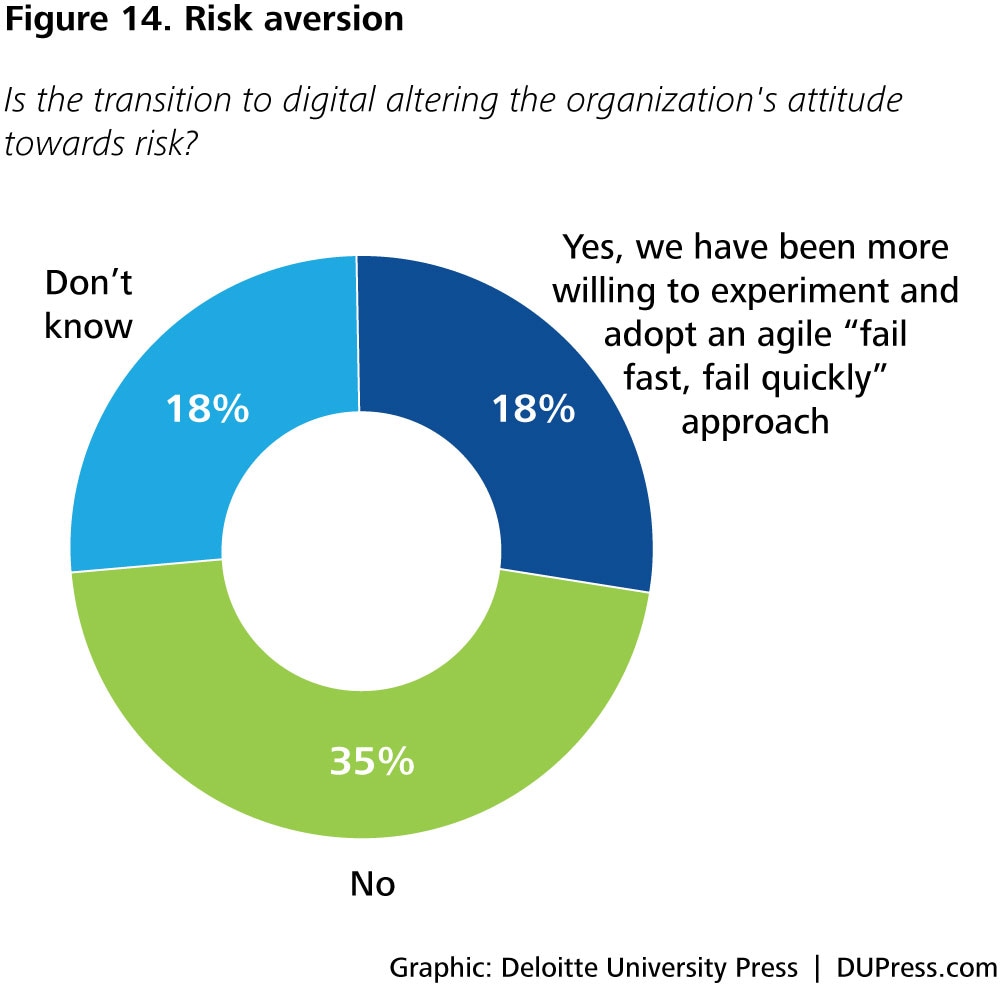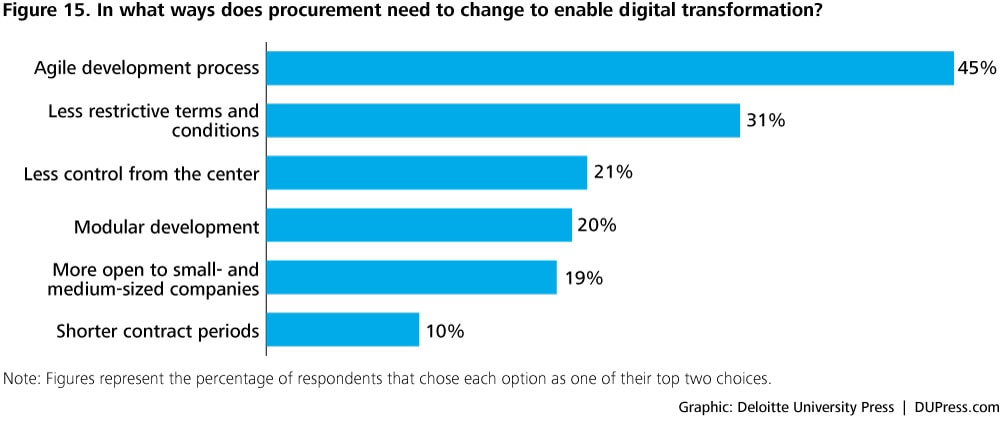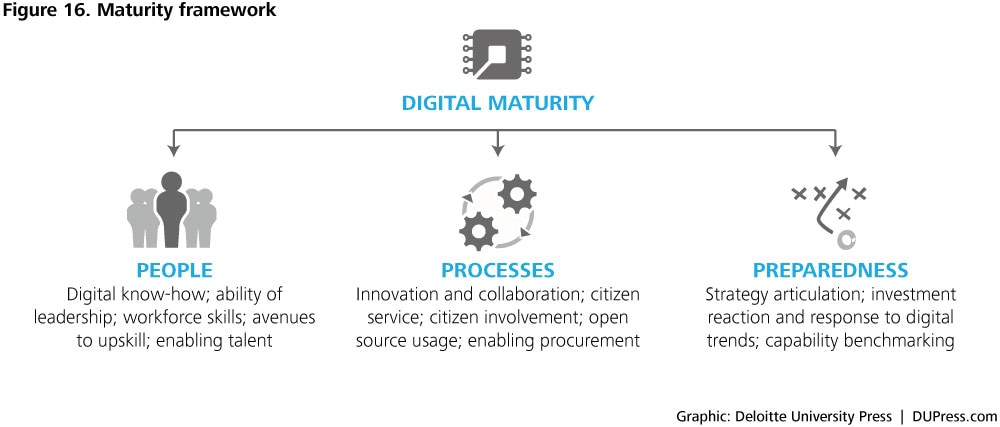The journey to government's digital transformation: Executive summary has been saved

The journey to government's digital transformation: Executive summary
02 October 2015
Five things can help public sector leaders make digital transformation happen: Strategy, leadership, workforce development, user focus, and culture.
Read the full report and view the related infographic.
Introduction
Governments from Toronto to Seoul are in the midst of a historic (and frequently wrenching) transformation as they abandon analog operating models in favor of their digital counterparts.
We surveyed more than 1,200 government officials from over 70 countries on digital transformation.* Overwhelmingly, they told us that digital technologies are having a major impact on government. Three-fourths of the respondents said that digital technologies are disrupting the public sector; nearly all (96 percent) characterized the impact on their domain as significant.
*More than half of the survey questions were sourced from the 2015 MIT Sloan Management Review and Deloitte digital business study. For more details, please refer to the appendix.
Digital maturity model explained
Digital maturity refers to the extent to which digital technologies have transformed an organization’s processes, talent engagement, and citizen service models. The levels of maturity—“early,” “developing,” and “maturing”—were identified and assigned based on our digital maturity estimation framework.1
Another key finding of the global survey is that governments are at very different stages in their journey of digital transformation. A small percentage are what we consider “maturing,” but the overwhelming majority are still in the early or developing stages of this journey (figure 1).
We have been careful to refer to governments as “digitally maturing” rather than “digitally mature” because we are still at the early stages of the journey to digital transformation and governments have yet to reach the end state.
Only about 30 percent of organizations surveyed assessed their digital capabilities as ahead of their public sector peers; nearly 70 percent said they lagged behind the private sector (figure 2). Respondents’ overall satisfaction with their organization’s current reaction to digital trends and their confidence in its readiness to respond to digital trends were also low.
Cost and budget pressures and citizen demands are far and away the two primary drivers of digital transformation, accounting for 75 percent of responses, whereas only 14 percent of organizations are driven by government directives.
Characteristics of a digitally maturing government
What separates digital leaders from the rest is a clear digital strategy combined with a culture and leadership poised to drive the transformation (table 1).
Digitally maturing organizations have a clear strategy aimed at fundamental transformation
Factors that influence digital transformation
In addition to the survey, we conducted more than 140 interviews with public sector leaders involved in digital transformation. From the interviews emerged five factors shaping digital transformation: strategy, leadership, workforce skills, digital culture, and user focus (table 1). We examined how organizations at each level of maturity behave with respect to these five factors.
An organization’s digital maturity is influenced, to a great degree, by its digital strategy. Among respondents from government organizations at the early stages of maturity, only 14 percent say that their organizations have a clear and coherent digital strategy (figure 3). In case of more digitally mature organizations, the number grows sixfold to 86 percent.
Our research also found that digital strategies at early-stage organizations have more of an operational focus, such as increasing efficiency. Only about a third cite transforming their business model as an objective (table 2).
Digitally savvy leadership is a game changer
Just 38 percent of survey respondents believe their leadership has sufficient skills for meeting the challenge of digitally transforming public services. Employees in digitally maturing organizations are more confident in their leaders’ ability to navigate the digital game. Only a tiny fraction of respondents from early-stage organizations, however, have the same level of confidence in their leaders (table 3).
Digitally maturing organizations build skills to realize their digital strategy
Maturing digital organizations invest in bridging skill gaps. More than 77 percent of respondents from these organizations report that their organizations are able to build the necessary skills to benefit from digital trends. Among less mature organizations, the number plummets to just 6 percent (figure 4).
Digitally maturing organizations have greater user focus
A variety of factors may guide a public sector organization’s journey of digital transformation, but it’s clear that citizen needs become more prominent as an agency moves up the maturity curve. Indeed, maturing organizations are nearly twice as likely as early-stage organizations to be driven by customers’/citizens’ demand for digital transformation (figure 5).
A laser focus on using digital technologies to improve the citizen experience helps maturing organizations improve service delivery. Not surprisingly, maturing organizations also say overwhelmingly that digital trends are improving their citizen/customer service quality (figure 6).
Digitally maturing organizations challenge cultural norms
Digitally maturing organizations are characterized by a culture that favors digital transformation. They nurture innovation, foster collaborative work environments, and are more adept at taking risks—more willing to experiment with agile, “fail fast, fail quickly” approaches (figure 7).
They are nearly three times as likely as those from early-stage organizations to report an improvement in their innovative and collaborative culture owing to digital trends (figure 8).
Barriers and challenges to digital transformation
Our survey asked respondents to identify the main barriers to digital transformation. The results show two barriers standing out, with nearly 40 percent of respondents citing them as the most significant: insufficient funding and too many competing priorities (figure 9).
Many public bodies struggle to fund core citizen services, let alone investments in digital initiatives—even though digital transformation is widely recognized as a route to substantial cost savings. While 82 percent of organizations perceive digital technologies as an opportunity, only 44 percent managed to increase investment in those initiatives over the last fiscal year (figure 10).
Most government organizations lack the strategy to achieve digital transformation
Our survey of public sector leaders finds that:
- Only 46 percent of public sector agencies have a clear and coherent digital strategy.
- 71 percent of organizations with a clear and coherent digital strategy report that digital trends are improving their agency’s ability to respond to opportunities and threats, against just 45 percent of organizations without a digital strategy.
While strategy forms the bedrock of the transformation process, leaders may not even realize its significance or importance. Only 46 percent of those surveyed say their organizations have a clear digital strategy (figure 11).
The lack of digital workforce skills represents a major obstacle to transformation
Our survey of public sector leaders finds that:
- 90 percent of organizations say that workforce issues are a challenging area to manage in their agency’s digital transformation.
- Only 34 percent say their organization has sufficient skills to execute its digital strategy.
- Only 33 percent say their organization provides the right resources or opportunities to obtain the digital skills they need.
A tech-savvy workforce is integral to any organization’s digital transformation strategy. This isn’t limited to technical skills—it includes skills such as business acumen, willingness to work collaboratively, and an entrepreneurial streak (figure 12). Respondents identify agility, entrepreneurial spirit, and technological literacy as the three skills most lacking in relation to digital transformation.
Agencies lack key elements of a “digital mindset”—customer focus, open functionality, and agile development
Our survey of public sector leaders finds that:
- More than 85 percent of the organizations cite culture as a challenging aspect of managing the transition to digital.
- Citizen demand is identified as one of the primary drivers of digital transformation, but only 13 percent of agencies report high citizen involvement in the co-creation of digital services.
- Only 23 percent report using open-source technology to a moderate or great extent.
- Only 28 percent of government agencies report that digital is altering their attitude toward risk, making them more willing to experiment with agile, iterative approaches.
Existing cultural norms often make embedding the tenets of digital—user focus, open functionality, and agile development—within the organization challenging. Organizations across domains and functions face cultural barriers in digital transition (figure 13).
Customers are front of mind for public leaders, but they are rarely at the heart of service design
Even for agencies that say citizen demand is the primary driver of digital transformation, the share significantly engaging with customers and users to co-create digital services still remains low, at 16 percent.
Less than 10 percent of front-line service delivery respondents engaged in interaction with citizens as part of their daily jobs report high citizen involvement in the co-creation of digital services. Similarly, law and justice and health care agencies frequently interact with citizens but have among the lowest percentage of respondents being driven by customer/citizen demands (less than 25 percent); they also lag in engaging citizens in the co-creation of digital services.
Digital is not yet altering risk aversion in government
Only 28 percent of government agencies report that digital is altering their attitude toward risk, making them more willing to experiment with agile, iterative approaches (figure 14).
Surprisingly, given American business culture’s emphasis on risk-taking, only 18 percent of US government agencies say that digital is altering the organization’s attitude toward risk, among the lowest percentage of any major country.
Procurement processes need to get in step with digital transformation
Our survey of public sector leaders finds that:
- 76 percent say that procurement needs to change to accommodate digital transformation, especially to allow for agile development and de-restrict terms and conditions.
- Respondents identify regulations, lack of flexibility, and lack of procurement skillsets as the most significant obstacles to digital-friendly procurement.
- 73 percent of organizations use both in-house and contracted resources to deliver services, but only 27 percent say they are satisfied with their vendor community.
Procurement processes are muzzled by regulations and lack of flexibility
Our research shows that there is widespread recognition that procurement and commercial strategies need to change fundamentally to accommodate digital transformation, and this frustration is seen across regions, countries, and government sectors. Asked to specify in what ways procurement needs to change, respondents primarily seek support for agile development and relaxation of control from the center (figure 15).
Satisfaction with technology vendors is low
While respondents see current procurement rules as hampering digital transformation, vendors’ ability is also a factor. Forty percent of respondents from the HR function outsource the development of their digital services (the highest percentage across functions), but not one of these respondents reports satisfaction with the vendor community.
Accelerating digital transformation
Key questions public leaders need to consider
- No. 1: Strategy. Do we have a clear and coherent digital strategy that addresses the key elements of digital transformation?
- No. 2: User focus. How can citizens and service users be part of our digital transformation?
- No. 3: Culture. What have we done to strengthen our organization’s innovative and collaborative culture?
- No. 4: Workforce skills. Have we looked at our talent pool and planned where our skills will come from?
- No. 5: Procurement. Are our organization’s existing procurement processes suitable to procure digital solutions?
Government organizations that achieve success with digital transformation will be more flexible, adapting to the one constant of the new digital age: change itself. They will re-imagine their services and continually innovate the way they engage with customers. Continued digital evolution may see some public bodies struggle as the environment changes around them; others, by taking advantage of all that digital transformation can offer, will thrive.
Appendix
About the survey
Between January and March 2015, Deloitte conducted the Global Digital Transformation 2015 survey covering more than 1,200 officials working in various government agencies, departments, and public sector bodies. Respondents included heads of departments, agencies, CIOs, CTOs, and CFOs across domains at all levels of government.
Survey questions and data
- About 60 percent of the survey questions were sourced from the 2015 MIT Sloan Management Review and the Deloitte digital business study. The remaining questions were framed and added to the survey to assess specific public sector areas such as procurement, co-creation, and use of open-source technology.
- The survey garnered a total of 1,205 responses globally. About 21 percent (248 responses) were from the 2015 MIT Sloan Management Review and the Deloitte digital business study. The rest of the responses were from a global public sector survey deployed between January and March 2015.
- To learn more about the 2015 MIT Sloan Management Review and Deloitte digital business study, please refer to the report Strategy, not technology, drives digital transformation.2
Digital maturity estimation framework
We adopted a holistic approach to estimate an organization’s digital maturity based on 20 questions from our survey. These questions were grouped into three broad categories: people, processes, and preparedness—areas we identified as important determinants of an organization’s digital maturity.
Each question was mapped to a Likert scale of 1–5, in which 1 reflects the least and 5 the highest score on the maturity scale. We calculated each respondent’s digital maturity as the average score of all questions. The maturity level cut-off scores used in the analysis were: early (0–3), developing (3.01–4), and maturing (4.01–5).
Deloitte Digital is a digital consulting agency that brings together the creative and technology capabilities, business acumen, and industry insight needed to help transform our clients’ businesses. Learn more at www.deloittedigital.com.
© 2021. See Terms of Use for more information.





